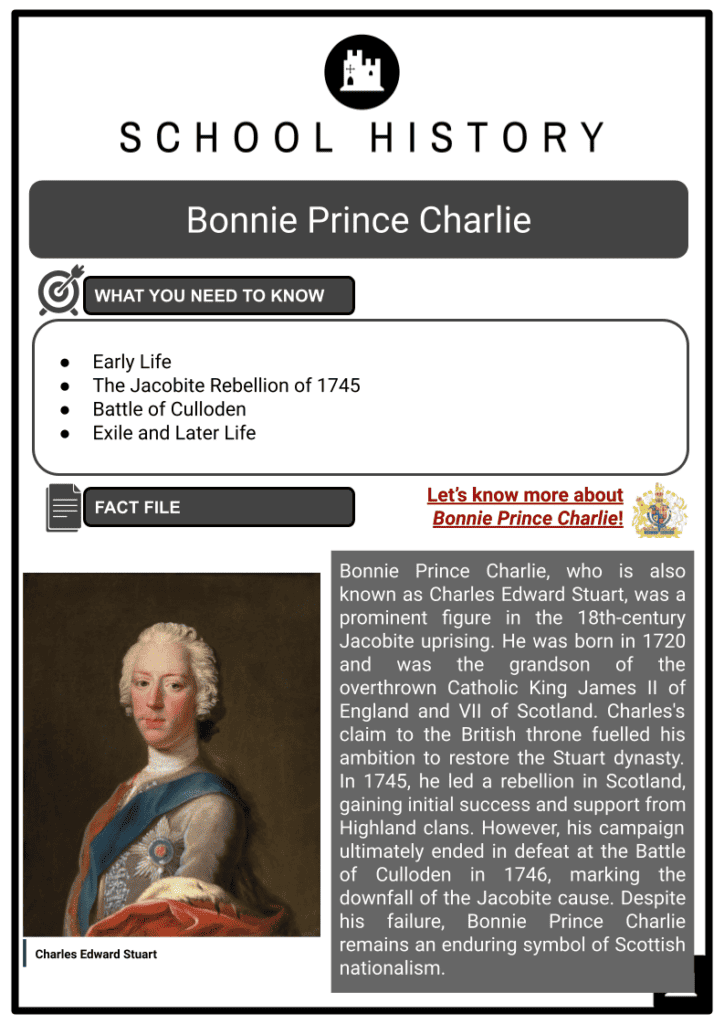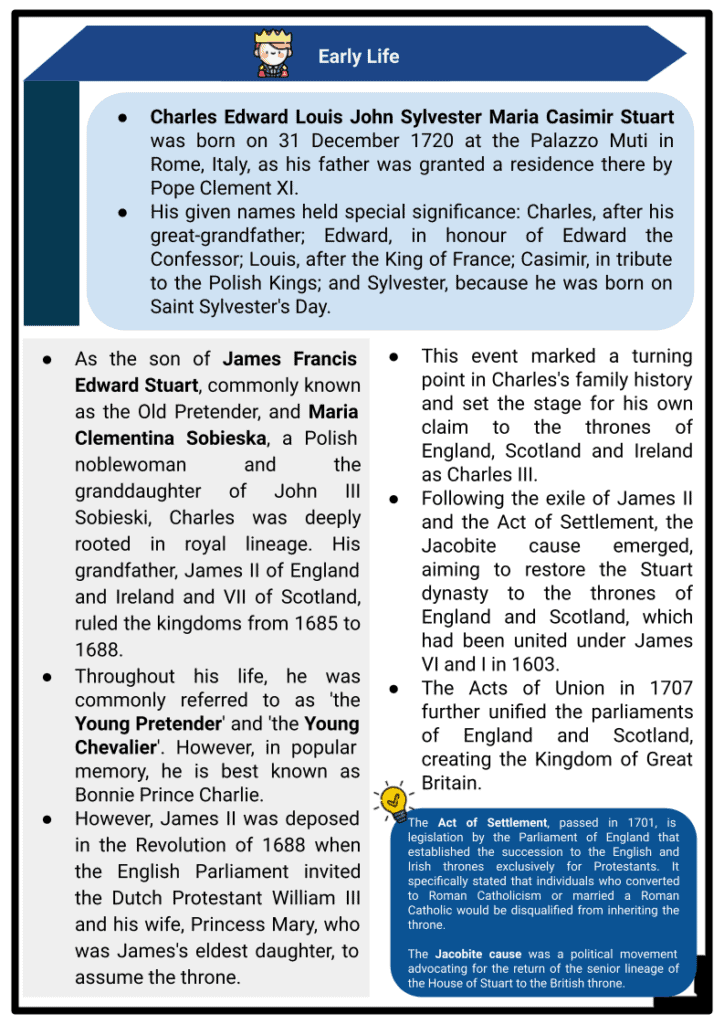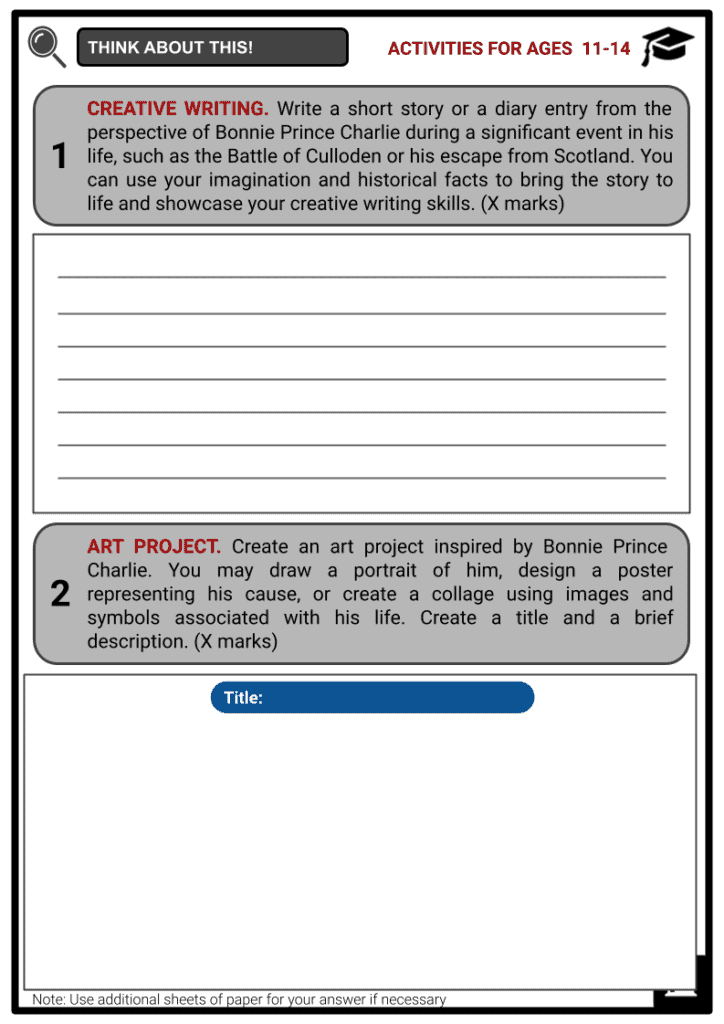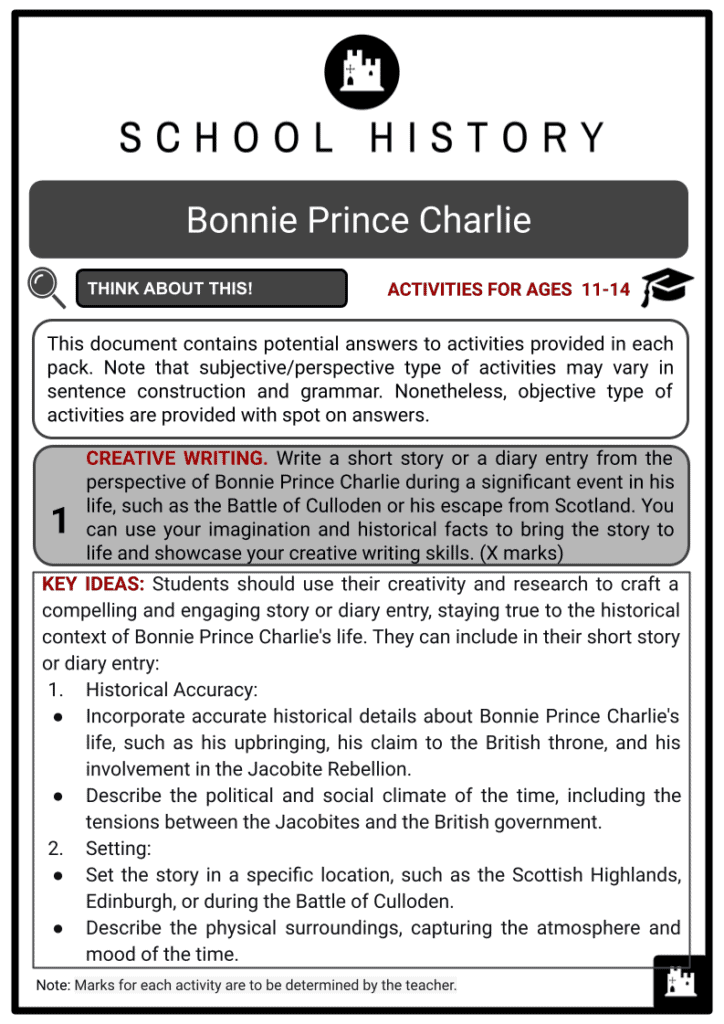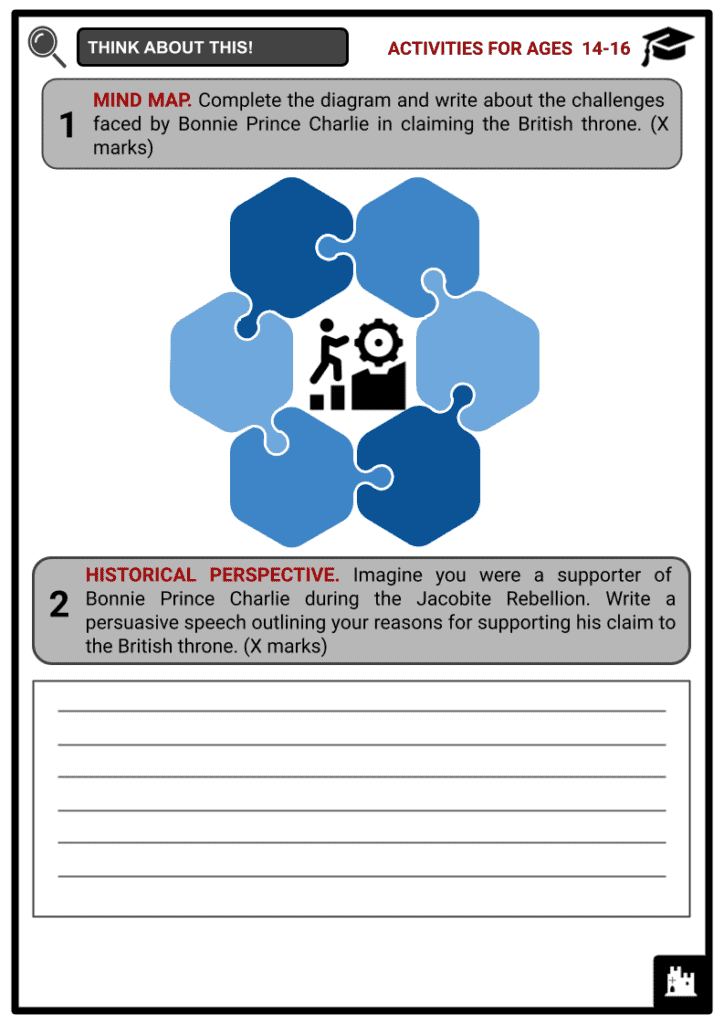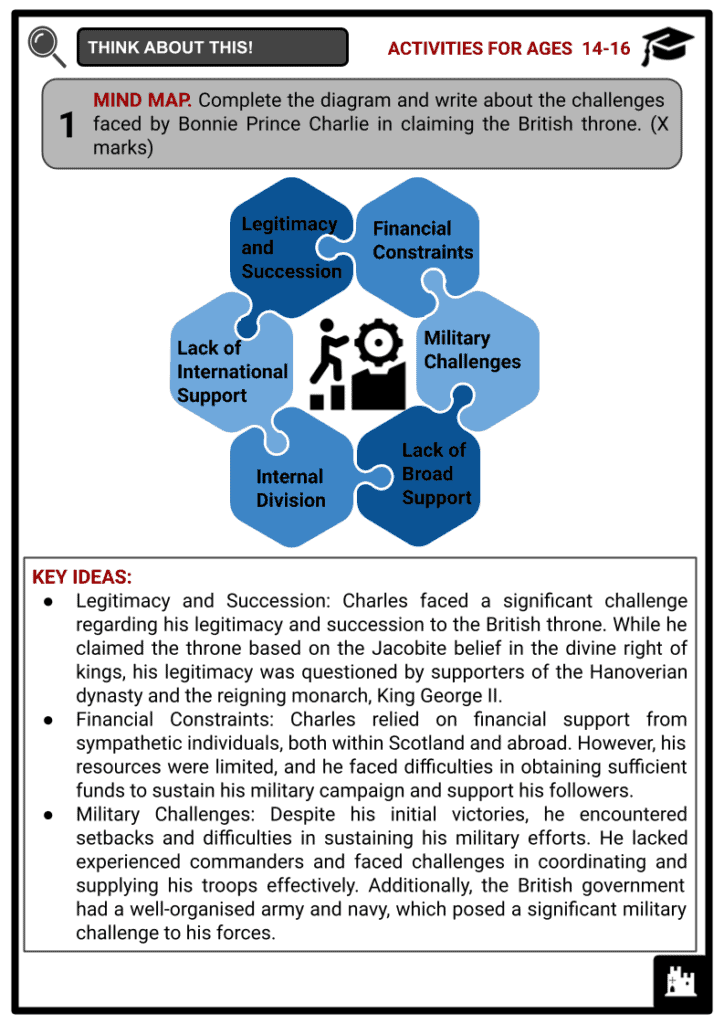Bonnie Prince Charlie Worksheets
Do you want to save dozens of hours in time? Get your evenings and weekends back? Be able to teach about Bonnie Prince Charlie to your students?
Our worksheet bundle includes a fact file and printable worksheets and student activities. Perfect for both the classroom and homeschooling!
Summary
- Early Life
- The Jacobite Rebellion of 1745
- Battle of Culloden
- Exile and Later Life
Key Facts And Information
Let’s know more about Bonnie Prince Charlie!
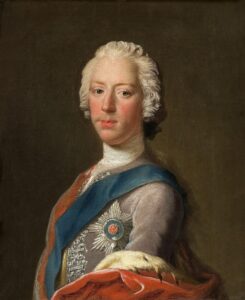
Bonnie Prince Charlie, who is also known as Charles Edward Stuart, was a prominent figure in the 18th-century Jacobite uprising. He was born in 1720 and was the grandson of the overthrown Catholic King James II of England and VII of Scotland. Charles's claim to the British throne fuelled his ambition to restore the Stuart dynasty. In 1745, he led a rebellion in Scotland, gaining initial success and support from Highland clans. However, his campaign ultimately ended in defeat at the Battle of Culloden in 1746, marking the downfall of the Jacobite cause. Despite his failure, Bonnie Prince Charlie remains an enduring symbol of Scottish nationalism.
Early Life
- Charles Edward Louis John Sylvester Maria Casimir Stuart was born on 31 December 1720 at the Palazzo Muti in Rome, Italy, as his father was granted a residence there by Pope Clement XI.
- His given names held special significance: Charles, after his great-grandfather; Edward, in honour of Edward the Confessor; Louis, after the King of France; Casimir, in tribute to the Polish Kings; and Sylvester, because he was born on Saint Sylvester's Day.
- As the son of James Francis Edward Stuart, commonly known as the Old Pretender, and Maria Clementina Sobieska, a Polish noblewoman and the granddaughter of John III Sobieski, Charles was deeply rooted in royal lineage. His grandfather, James II of England and Ireland and VII of Scotland, ruled the kingdoms from 1685 to 1688.
- Throughout his life, he was commonly referred to as 'the Young Pretender' and 'the Young Chevalier'. However, in popular memory, he is best known as Bonnie Prince Charlie.
- However, James II was deposed in the Revolution of 1688 when the English Parliament invited the Dutch Protestant William III and his wife, Princess Mary, who was James's eldest daughter, to assume the throne.
- This event marked a turning point in Charles's family history and set the stage for his own claim to the thrones of England, Scotland and Ireland as Charles III.
- Following the exile of James II and the Act of Settlement, the Jacobite cause emerged, aiming to restore the Stuart dynasty to the thrones of England and Scotland, which had been united under James VI and I in 1603.
- The Acts of Union in 1707 further unified the parliaments of England and Scotland, creating the Kingdom of Great Britain.
- The Act of Settlement, passed in 1701, is legislation by the Parliament of England that established the succession to the English and Irish thrones exclusively for Protestants. It specifically stated that individuals who converted to Roman Catholicism or married a Roman Catholic would be disqualified from inheriting the throne. The Jacobite cause was a political movement advocating for the return of the senior lineage of the House of Stuart to the British throne.
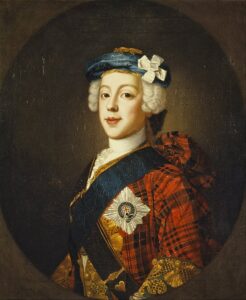
Prince Charles Edward Stuart, portrait by William Mosman - During his early childhood, Charles resided in Rome and Bologna, accompanied by a small retinue and his sometimes argumentative family. His brother, Henry Benedict Stuart, was born five years later on 6 March 1725.
- As the legitimate heirs to the English, Scottish and Irish thrones, according to the Jacobite succession, James and his household carried a deep sense of pride and unwavering belief in the divine right of kings.
- During his early years, Charles was primarily surrounded by older men who acted as his tutors. His governor, James Murray, the Jacobite Earl of Dunbar, was a Protestant. While the Pope had expressed worries about Charles' religious upbringing under a Protestant government, James accepted that Charles would be brought up as a Catholic.
- Charles received education from various tutors, including Chevalier Ramsay, Sir Thomas Sheridan and Father Vinciguerra, who was a Catholic priest. Through their guidance, he learnt English, French and Italian, although some accounts suggest that he never achieved complete mastery of any language and had limited literacy skills.
- During his youth, he took pleasure in activities such as hunting, horsemanship, a variant of golf, music and dancing.
- In 1734, Charles's cousin, the Duke of Liria, visited Rome on his way to join Don Carlos in his campaign to claim the throne of Naples.
- The Duke offered Charles the opportunity to accompany him, and despite being only 13 years old, Charles was appointed general of artillery by Don Carlos.
- Departing from Rome in July 1734, he joined his cousin in the French and Spanish siege of Gaeta, marking his first exposure to the realities of warfare.
- While at Gaeta, Charles witnessed the final stages of the siege and even faced enemy fire in the trenches.
- Charles returned to Rome later in the year. Tragically, in January 1735, shortly after Charles's 14th birthday, his mother, Clementina, passed away due to scurvy.
- Her declining health had been a concern for several months, and Charles was deeply saddened by her loss.
- As Charles entered adulthood, he was introduced to Italian society through the efforts of his father and the Pope. In 1737, James arranged for his son to venture on a tour of major Italian cities, aiming to provide him with a comprehensive education as a prince and a worldly individual.
- Charles visited notable destinations such as Genoa, Florence, Parma, Bologna and Venice during his journey. However, the Italian tour proved to be a disappointment for Charles, as he had expected to be received as a royal prince but was mostly acknowledged as the 'Duke of Albany' by European courts.
- Despite his Catholic faith, many European states – with the exception of Venice – sought to avoid causing conflicts with Britain. At the age of 20, Charles had already gained significant recognition and influence among the elite circles of Rome's upper-class society and had developed a penchant for alcohol and extravagant clothing, often exceeding his allotted budget.
- Due to Henry's strong dedication to prayer and religious studies, Charles gradually grew apart from his brother. While their father relied on foreign aid for his restoration efforts, Charles began to favour the idea of rebellion without external support.
- Recognising Charles's limited ability to travel to Britain, James appointed him as prince regent on 23 December 1743, granting him the authority to act on his behalf.
- In February 1744, the French government made a decision to assist in a planned invasion of England as part of their strategy in the War of the Austrian Succession.
- Charles embarked on a journey to Dunkirk with the intention of joining the French Army to cross over to England. However, the invasion plan was foiled when a storm during the spring equinox scattered the French fleet, resulting in the loss of 11 ships. By the time the fleet regrouped, the British fleet had become aware of the diversion and resumed their position in the Channel.
- Following the unsuccessful invasion attempt, Charles decided to remain in France, residing in various locations such as Gravelines, Chantilly and Paris. In May 1744, he leased a house on a hilltop in Montmartre.
- However, due to his extravagant spending on clothing, entourage and drinking, Charles found himself in debt amounting to 30,000 livres. As news of his financial situation and the failed invasion spread, the French authorities tried to persuade him to return to Italy by withholding his monthly subsidy.
- Eventually, unable to afford the rent for the house in Montmartre, Charles was offered temporary accommodation at the country estate of the Archbishop of Cambrai near Paris, where he stayed until January 1745.
- Afterwards, Charles relocated to the countryside residence of Anne, Duchess of Berwick in Soissons, as the French authorities persistently urged him to depart from the Paris region.
- Nonetheless, Charles maintained a regular pattern of travel to Paris during this time, often disguising his identity and visiting various hotels in the city to meet with his supporters.
The Jacobite Rebellion of 1745
- During his time in Rome and Paris, Charles encountered many supporters of the Stuart cause, realising that Jacobite representatives were present in influential European courts.
- He actively engaged in extensive correspondence and various activities aimed at advancing his own and his father's interests. In Paris and Soissons, Charles diligently sought financial backing and support to facilitate the restoration of the monarchy.
- Jacobitism was a political movement that aimed to reinstate the senior branch of the House of Stuart to the throne of Britain. The term 'Jacobitism' derives from the Latin form of the name James, which is Jacobus, referring to James II of England and Ireland, and VII of Scotland.
- With determination, Charles made the decision to embark on an expedition to Scotland. The primary objective was to spark a rebellion that would pave the way for his father's ascent to the thrones of England, Scotland and Ireland.
- Charles borrowed 180,000 livres from the Paris bankers John and George Waters to fund the expedition.
- He used it to procure weapons and equip two vessels: the Elisabeth, an old man-of-war with 66 guns, and the Du Teillay, a 16-gun privateer.
- On 5 July 1745, Charles and his entourage embarked on their journey to Scotland.
- Anticipating a warm reception from various Highland clans, both Catholic and Protestant, who still held allegiance to the Jacobite cause, Charles aimed to rally support for a widespread Jacobite uprising across Britain.
- However, when they arrived, they were greeted with a cold reception from the clan leaders.
- Many, including MacDonald of Sleat and Norman MacLeod, advised Charles to return to France. Concerned about the potential consequences of a defeat, they questioned Charles's ability to fulfill his commitments and doubted his leadership capabilities, particularly in the absence of French military support.
- Unfazed by the lack of support from the French fleet he had anticipated, Charles embarked on another voyage and reached the bay of Loch nan Uamh. While he had initially relied on the prospect of assistance from a French fleet, it became clear that such support was not forthcoming. In light of this, Charles made the decision to raise an army in Scotland independently.
- Despite facing initial discouragement from some clan chiefs, Charles managed to secure crucial support from Donald Cameron of Lochiel. Charles offered a guarantee for the full value of Lochiel's estate in case the uprising failed, which convinced Lochiel to join the cause. This alliance marked a turning point, and support for Charles's campaign increased. Charles also started taking lessons in conversational Gaelic.
- After Bonnie Prince Charlie arrived in Scotland, news of his presence quickly reached London. As a result, a substantial bounty of £30,000 was placed on his head, which would be equivalent to around £5 million today.
- However, Bonnie Prince Charlie remained undeterred and began his campaign by marching south. On 11 September, he arrived in Edinburgh, where he faced no resistance and was warmly welcomed by cheering crowds.
- Although Edinburgh Castle was still held by government troops, Charles established his headquarters at Holyrood Palace. During the time he spent in Edinburgh, he earned the nickname 'Bonnie Prince Charlie' due to the admiration he received from the city's female population who had gathered to see him.
Battle of Prestonpans
- The Jacobite army faced its first battle test on 21 September near Prestonpans, a few miles east of Edinburgh. Despite being outnumbered by government forces, the Jacobites emerged victorious. The government troops, lacking proper training and experience, were easily overwhelmed by the fierce highland charge, a tactic where the Scots charged at full speed towards the enemy, causing them to scatter in fear.
- The battle was short-lived, lasting less than an hour, but it provided a significant boost to the Jacobite cause.
England Invasion (1745–1746)
- After his triumph in Edinburgh, Charles returned to plan his next move, but disagreements arose between him and his council.
- While Charles was determined to invade England and secure the British throne for his family, his council members believed it would be wiser to consolidate their campaign in Scotland, await French aid, and let the English forces come to them.
- Despite their strong objections, the force of Charles's personality persuaded the council to agree with his plans.
- However, their reluctance to follow his invasion scheme would soon lead to significant problems for Charles's ambitions.
- During the six weeks of indecision following Prestonpans, divisions within the Jacobite ranks became apparent, and gave the government forces time to prepare.
- Undeterred, Charles embarked on his march south with an army of approximately 6,000 soldiers.
- Crossing the border, he triumphantly entered England on 8 November 1745.
- His forces swiftly captured the city of Carlisle, but his commanders remained concerned. They urged Charles to wait in Carlisle for the English Jacobites to rise up.
- However, Charles's determination to reach London overruled all other opinions, and he insisted on continuing the march.
- Upon reaching Derbyshire, Charles's council made the decision to retreat to Scotland, despite his objections. The lack of English Jacobite and French support, along with rumours of significant government forces being assembled, influenced their choice.
- Charles acknowledged that he had not heard from the English Jacobites since leaving France, despite claiming otherwise, which deeply harmed his relationship with some Scots.
- The Jacobites and Charles left Derby on 6 December and began their march north back to Scotland.
- After reaching Glasgow on 26 December, Charles and his forces took a break until 3 January 1746.
- They then decided to lay siege to Stirling and Stirling Castle. Although the town surrendered quickly, the castle's artillery was too powerful for the Jacobite forces to capture.
- The government forces attempted to relieve the siege, leading to the Battle of Falkirk Muir in January 1746, which Charles won.
- However, since they couldn't capture the castle, they had to abandon the siege and move northwards to Crieff and then Inverness.
- They rested in Inverness until the weather improved but were later pursued by the forces of Prince William, Duke of Cumberland, the son of George II.
Battle of Culloden
- On 16 April, during the Battle of Culloden, Charles and his army faced the British forces. Despite the advice to choose a better battlefield, Charles decided to fight on open, marshy ground.
- His officers requested that he command from a safer position, but this limited his view of the battle. Charles hoped the British would attack first, so he exposed his men to their artillery fire.
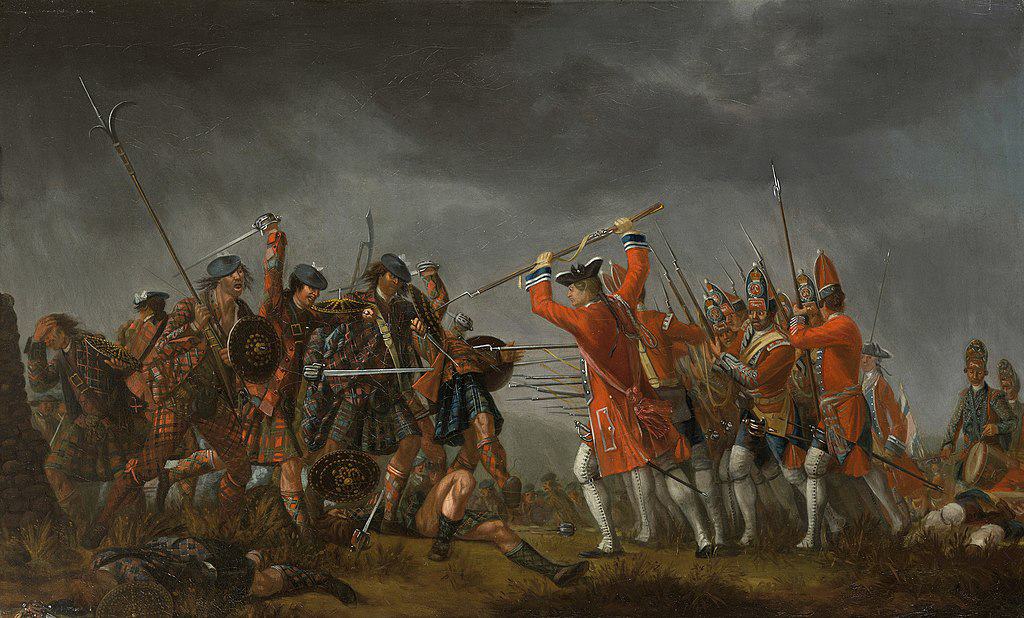
The Battle of Culloden depicted in an oil painting by David Morier - Realising his mistake, he ordered an attack, but the message was not delivered. The Jacobite attack was disorganised and met with heavy fire, resulting in little success.
- The Jacobites advanced towards the redcoats in the centre but were met with gunfire from a second line of soldiers, resulting in heavy casualties. The remaining Jacobite soldiers in the front line quickly retreated.
- However, the regiments from the northeast, along with Irish and Scots regulars in the second line, were able to withdraw in an organised manner, providing Charles and his close followers an opportunity to escape northwards.
- Following the defeat, General Lord George Murray successfully led a faction of Jacobites to Ruthven with the intention of continuing the fight.
- However, Charles, suspecting betrayal, chose to abandon the Jacobite cause. He sought refuge in the Highland moors of Scotland and subsequently made a daring escape to the Hebrides, constantly evading the pursuing government forces.
- Throughout his escape, Charles received assistance from numerous Highlanders, who remained loyal and did not betray him despite the £30,000 reward on his head.
- On 28 June, Flora MacDonald assisted Charles by helping him sail to the Isle of Skye, disguising him as her maid named Betty Burke on a boat.
- Charles stayed on Skye until July, and then crossed back to the mainland. With the help of a few loyal servants and local supporters, he hid from government forces in the western Grampian Mountains for several weeks.
- He managed to escape capture, and on 19 September, he left the country on the French frigate L'Heureux, commanded by Richard Warren.
Exile and Later Life
- Charles returned to France on 10 October 1746. Initially, he received a warm welcome from King Louis XV, but his attempts to obtain further military or political assistance were unsuccessful.
- During his time in France, Charles had multiple mistresses. One of them was his first cousin, Marie Louise de La Tour d'Auvergne, who was married to Jules, Prince of Guéméné. They had a son named Charles, who unfortunately passed away at a young age.
- In December 1748, Charles was arrested by French authorities while attending the opera.
- He was briefly imprisoned at the Château de Vincennes before being banished from France under the conditions of the Treaty of Aix-la-Chapelle, which ended the Austrian Succession War.
- Charles first moved to Avignon in the Papal territory and later settled in Lunéville in the Duchy of Lorraine in 1749.
- Following his defeat, Charles communicated to the remaining Jacobite supporters in England that he recognised the difficulty of reclaiming the English and Scottish thrones as a Catholic.
- Therefore, he expressed his willingness to rule as a Protestant instead.
- In 1750, he secretly visited London and stayed for a few weeks at Lady Primrose's residence on Essex Street. During his time in London, Charles renounced the Catholic faith and embraced the Protestant faith by receiving Anglican communion.
- After his exile, Charles resided with his Scottish mistress, Clementina Walkinshaw, who later became known as Countess von Alberstrof. It is believed that they met and possibly initiated a relationship during the 1745 rebellion.
- On 29 October 1753, they had a daughter named Charlotte.
- However, Charles struggled to cope with the downfall of the Jacobite cause, which led to his issues with alcohol.
- Eventually, with the help of his father James, Clementina and their daughter separated from Charles.
- Following the death of Charles's father on 1 January 1766, Charles reached out to the kings of France and Spain to claim his position as King Charles III, but unfortunately, neither monarch granted him recognition.
- He then resumed his social life in Rome, engaging in activities like hunting, shooting and attending balls, concerts and plays.
- He also made visits to the Pope. However, there were times when he secluded himself in his rooms, and it was noted that he did not form any new friendships in his later years.
- As Charles reached the age of 51, concerns arose among his Jacobite supporters and the French about his unmarried status, as his only remaining male heir was his brother, who was a celibate priest.
- The French also saw the continuation of the Stuart line as a potential tool against the British government. A few months later, Charles's friend, the Duc d'Aiguillon, and his cousin Charles Fitz-James Stuart proposed Princess Louise of Stolberg-Gedern as a potential spouse.
- On 28 March 1772, Charles married Princess Louise through a proxy ceremony. They initially resided in Rome and later moved to Florence in 1774, where Prince Corsini provided them with a residence at the Palazzo di San Clemente.
- In Florence, Charles used the title 'Count of Albany', and his wife Louise was commonly referred to as the 'Countess of Albany'.
- Charles's health declined in his later years, and he suffered from asthma, high blood pressure, swollen legs, and ulcers. In 1774, while in Florence, his illnesses caused constant discomfort, requiring his servants to carry him to and from his carriage.
- In 1777, Charles and Louise departed Florence and went back to Rome. Unfortunately, their relationship had grown increasingly strained.
- In November 1780, Louise formally separated from Charles and, as a result, the Pope granted her half of Charles's papal pension.
- Charles's life became more isolated and unhappy, particularly after his brother Henry agreed to provide housing for Louise on his estate.
- By 1783, Charles's health had deteriorated further, and he had experienced a serious illness. Although he eventually recovered, he decided to create a new will and signed an act of legitimation for his daughter Charlotte, who was born out of wedlock.
- During his final years, Charles divided his time between Florence and Rome. However, in 1785, he departed Florence for the last time and returned to Rome. Due to his fragile state, his doctors advised him to limit his travels to lighter journeys.
- Charles passed away in Rome at the age of 67 on 30 January 1788, due to a stroke. Charles's will gave the majority of his estates to his daughter, Charlotte, with a few exceptions, like providing some belongings to his brother Henry and granting annuities to his servants.
- After his death, a cast of Charles's face was made, and his body was preserved. Charles was initially laid to rest in Frascati Cathedral near Rome, where his brother Henry served as a bishop.
- When Henry passed away in 1807, Charles's remains (excluding his heart) were transferred to the crypt of St Peter's Basilica in the Vatican. There, he was buried alongside his brother and father. This resting place was below the spot where Antonio Canova's monument to the Royal Stuarts would be later erected.
- Charles's mother, Maria, is also buried nearby at St Peter's. His heart, however, remained in Frascati Cathedral, housed in a small urn beneath the floor with a monument dedicated to it.
Image Sources
- https://en.wikipedia.org/wiki/Charles_Edward_Stuart#/media/File:Lost_Portrait_of_Charles_Edward_Stuart.jpg
- https://en.wikipedia.org/wiki/Charles_Edward_Stuart#/media/File:William_Mosman_-_Prince_Charles_Edward_Stuart,_1720_-_1788._Eldest_son_of_Prince_James_Francis_Edward_Stuart_-_Google_Art_Project.jpg
- https://en.wikipedia.org/wiki/Battle_of_Culloden#/media/File:The_Battle_of_Culloden.jpg

